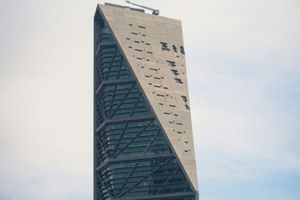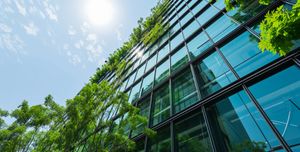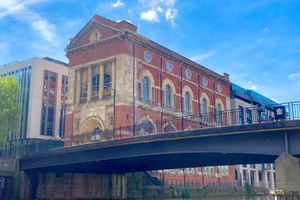The last decade has seen a major shift in global population trends, with more people choosing urban life. Over 4 billion people - more than half of the global population - now live in cities, and as a result, cities consume around 75% of all energy and emit 50-60% of the world’s greenhouse gases.
By 2050, it is estimated that approximately 7 in 10 people will live in urban areas. As our cities grow bigger, they’ll not only contribute more to global warming, but they’ll also be at increased risk of the impacts of climate change, such as flooding and heat waves.

To mitigate this risk, urban centres are reducing their ecological footprints through more environmentally-friendly buildings, renewable energy sources, and energy efficiency measures. Greener buildings are key to achieving more sustainable urban development as our cities’ populations continue to grow.
Energy efficiency is our business at Best.Energy, but fighting climate change is everyone’s responsibility! So, creating greener buildings for a more sustainable future needs to become a priority for all of us.
The rise of eco-buildings

The U.S. Environmental Protection Agency estimates that 30% of the energy used in commercial buildings is wasted. So, buildings in our cities have enormous potential for energy efficiency!
Eco-friendly buildings are gaining popularity, with the potential to reduce energy consumption by 50% or more by 2050. So how can we create greener buildings in our urban spaces? Read on to uncover our top tips:
- Ensuring energy efficiency - Monitoring and targeting energy usage using smart technology like the innovative Eniscope can help us reduce a building’s energy footprint. We can’t manage what we can’t see, so this intelligent solution makes energy usage visible so that efficiencies can be made in surprising places. Alongside this, introducing renewable energy sources, such as solar panels, can help to further reduce emissions in the long-run too.
- Automating indoor environments - A lot of energy wastage comes from unnecessary use of lights, heating, cooling, and ventilation in unoccupied rooms. However, this can be combated by intelligent environmental monitoring using Eniscope and the interconnected wireless* Air suite* sensors. These solutions assess and adjust temperature, humidity, occupancy, lighting, and more, so that appliances, lights, and HVAC can be used more efficiently. Some buildings are now becoming even smarter with app control too!
- Pioneering design innovations - New buildings are an opportunity to introduce exciting innovations in sustainability, including eco-materials, new construction methods, and green strategies. There are some incredible innovations out there, including green living roofs; collecting and recycling rainwater for flushing toilets; reflective glass that keeps the heat of the sun out; and on-site solar panels or wind turbines.
- Retrofitting older buildings - New buildings are incomplete without a BMS at the helm. So, when a new building is being planned, designed, and constructed, it is an ideal opportunity to lay down the foundations for sustainability with a state-of-the-art BMS and energy management system like the Eniscope. Implementing a Building Management System in a new building is straightforward, but retrofitting older buildings doesn’t have to be complex. Older buildings can easily be modernised with state-of-the-art AI technology like the Eniscope platform. This energy management system is easy to install (practically plug-and-play), and the Air suite of sensors connects wirelessly too.
- Managing materials and resources - By saving energy and water during construction (and after construction), and incorporating sustainable building materials, we can limit the impact of new buildings by saving and protecting valuable resources. Low-carbon concrete is a fantastic way of incorporating more eco-friendly building materials during construction, and natural habitats can be improved by introducing beehives, greenery, and restored marine habitats too.
- Embracing digital technology - Forward-thinking technological advancements like AI can highlight patterns and anomalies in energy data to enable preventative maintenance. For example, installing Eniscope and implementing Virtual Energy Management uses machine-learning alongside human expertise to help you identify energy-draining equipment and flag maintenance issues before they become a problem.
Sustainable buildings around the world

Environmentally-friendly buildings using smart technologies like AI, IoT, and the Cloud, are leading the way in modern urban planning. These digital innovations are helping to improve the quality of life in our increasingly populated cities as we build a more sustainable future.
Many cities are already making strides towards becoming more environmentally friendly by introducing greener buildings. Here are a few examples of our favourite eco-friendly buildings from around the world:
The Edge, Netherlands
This amazing app-controlled, carbon-neutral building in Amsterdam is considered the “greenest and most intelligent building in the world.” Staff members are connected to it via a smart app, which finds available parking spaces, desks, or meeting rooms, and adjusts the environment for its occupants. Environmental sensors monitor and automatically adjust ambient temperature and lighting to prevent energy wastage.

Bosco Verticale, Italy
Taking ‘green’ to the next level, Bosco Verticale is a deluxe apartment complex that was designed with a living green facade bursting with trees, shrubs, and plants which help to improve the air quality in Milan.

Reforma Tower, Mexico
Mexico’s third tallest skyscraper makes the most of solar and wind power, and it even recycles water to generate electricity on-site. Smart sensors throughout the building optimise energy usage, and artificial intelligence controls the air conditioning system to avoid inefficiencies.

Parkroyal Collection, Singapore
This luxurious hotel, renowned for its 15,000m2 of sky gardens, is a green icon in the bustling city of Singapore. Designed to be self-sufficient and consume minimal energy thanks to energy-saving features seamlessly into the building (like solar cells, motion and light sensors, and rainwater collection), it has been named the ‘World’s Leading Green City Hotel’ in the World Travel Awards. It even has a rooftop farm which supplies the restaurant with a farm-to-table dining experience!

CopenHill, Denmark
This unique building in Copenhagen is not just known for being one of the world’s tallest climbing towers and having an artificial ski and snowboard slope. In fact, beneath this recreational centre lies a waste-to-energy plant that converts 440,000 tons of waste a year into electricity and heating for 150,000 nearby homes.

Vancouver Convention Centre, Canada
Aiming to be functional, beautiful, and green, Vancouver Convention Centre is the world’s first double LEED (Leadership in Energy and Environmental Design) Platinum-certified convention centre. Hosting a multitude of eco-solutions, the centre has a living roof with its own bee hives installed to pollinate its plants and grasses; a seawater heating and cooling system; and a restored marine habitat built into its foundations.

Beitou Public Library, Taiwan
With reduced water and energy consumption at its heart, Beitou Public Library was specially designed with large windows to maximise daylight, plus a large green, sloping turf roof which is partially covered with photovoltaic cells. This allows the building to generate energy and drain rainwater into tanks which can be used for irrigation and flushing toilets.

Pixel Building, Australia
The Pixel Building is Australia’s first carbon-neutral office building, featuring multi-coloured panels that provide shade and maximize daylight, and built with low-carbon concrete and sustainably-sourced materials. Alongside this, the Pixel Building generates its own power and water thanks to wind turbines and a green roof that uses evapotranspiration of greywater from the building.

Join the greener building revolution
As we’ve seen, creating greener buildings is not just an option but a necessity in our fight against climate change. From innovative technologies like the Eniscope energy management system to pioneering design innovations and sustainable construction practices, there are numerous ways we can make our urban spaces more eco-friendly.
At Best.Energy, we believe that every building can be transformed into a beacon of sustainability. Whether you’re retrofitting an old structure or planning a new development, the solutions are within reach. By embracing energy efficiency, utilising renewable resources, and incorporating intelligent building and energy management systems, we can significantly reduce our ecological footprint and build more sustainable urban spaces for the future.
So, join us in the greener building revolution and help create a more sustainable world for generations to come. Visit Best.Energy to learn more about how we can help you transform your building into a green, energy-efficient marvel.


